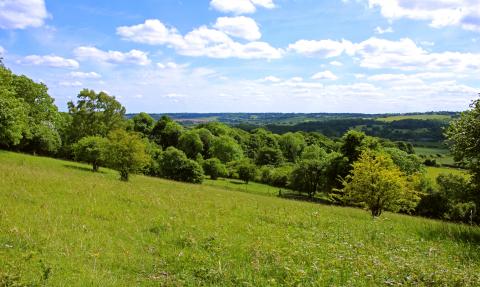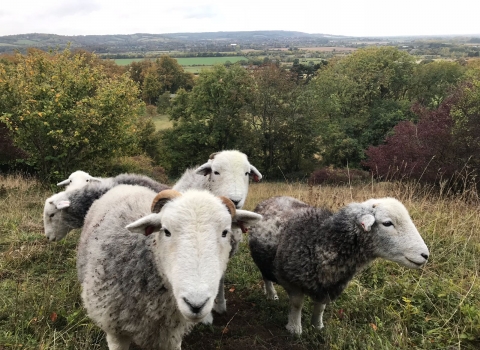
Aldbury Nowers (c) Josh Kubale
Managing nature reserves
We care for over 40 nature reserves across Hertfordshire and Middlesex with the help of dedicated volunteers. From nationally and internationally important wetlands to ancient woodlands and rare patches of heathland and a community orchard, we look after some of the best spots in South East England for wildlife.
Why do nature reserves need to be managed?
Every day, our Reserves Team is out on the reserves managing habitats. We do this to encourage the greatest diversity of species on our sites which is fundamental to the survival of our native wildlife.
If we left our woodlands unmanaged, we would soon lose the diversity of species that a mixture of woodland habitats supports. For example, creating clearings by removing some trees lets more light into the wood. This allows wildflowers and other plants to emerge. These support insects, which then provide food for animals further up the food chain, like birds and small mammals. The clearings also allow tree species to regenerate, creating a diversity of ages in the tree canopy and therefore increasing the sustainability of the woodland.
Similarly, if we left our grasslands to their own devices, they would eventually become woodland! Our grazing programme and regular cutting and raking ensure we are protecting special grassland wildlife. And restoring wetland features like reedbeds, most of which have been lost over time, provides nesting places and shelter for wetland birds.
We're making a difference
Nature is incredibly resilient. With a little help from us, it can bounce back. Here are some success stories from our reserves:
Aldbury Nowers awash with butterflies
Record numbers of butterflies were recorded at Aldbury Nowers Nature Reserve near Tring, including a new record for the locally scarce dark green fritillary.
The Trust has carried out extensive restoration work at the site to encourage the plants that butterflies like. Dark green fritillaries, for example, favour almost exclusively the common dog-violet and hairy violet to lay their eggs on.
Emerald damselfly tops the lot at Amwell
A former quarry, Amwell Nature Reserve has blossomed into a haven for wildlife and is one of the Trust's flagship sites. As well as being internationally important for its bird numbers, the reserve is also one of the best places in Hertfordshire for dragonflies - 19 different species have been recorded. In August 2013, the emerald damselfly was spotted, a scarce visitor but one which has been seen over the last two years, suggesting a small population of this local rarity has become established.
Why graze?
Grazing animals help us to manage particular sites in the most effective and natural way possible.
Centuries ago people cleared the land of trees to form open spaces for farming. Their grazing animals helped to shape many of our semi-natural habitats, which developed rich and diverse wildlife communities. Our grassland and heathland habitats were all shaped by human activity and grazing is often the most effective and sustainable way to maintain them and their huge variety of plants and animals.
Grazing benefits
Grazing animals eat selectively and often choose the more dominant plant species, which allows less competitive plants to become established and increases species diversity. As they graze across the landscape, the animals decide for themselves where to concentrate their efforts and create a mosaic of different lengths of grass and microhabitats.
Lying, rolling and pushing also serve to increase the structural diversity of the grass. This is important for ground-nesting birds like lapwing and snipe that need a varied grass structure to successfully rear their young.
Trampling creates areas of bare ground, which is beneficial in moderation. It creates nurseries for seedlings that might not otherwise survive and creates habitats and hunting grounds for open ground, warmth-loving invertebrates and reptiles.
Dung creates a whole ecosystem by itself! Conservation grazing animals are usually grazed in extensive, low-pressure systems so there is little need for chemicals to control internal parasites. This means that a whole range of wildlife moves into a cowpat to set up home - more than 250 species of insect are found in or on cattle dung in the UK and these, in turn, provide food for birds, badgers, foxes and bats.
Livestock grazing has a less instantaneous impact than cutting the grass, so it allows less mobile wildlife to thrive. The grazing animals can also access areas that machinery cannot.
Choosing the right beast for the job
The choice of livestock used for conservation grazing is very important. Differences in feeding preferences, physiology and behaviour mean that different animals and breeds are needed to manage different habitats.
Cattle
Cattle use their tongues to wrap around and pull up tufts of vegetation, leaving uneven sward lengths and producing a tussocky field. They will eat longer, coarser grasses and push their way through scrub and bracken to create open spaces. We currently use redpoll, a traditional East Anglian breed, to graze our sites.
Sheep
Sheep prefer to nibble shorter grasses but will also select flower heads, which can result in a decrease in species diversity if not properly managed. Many traditional and hill breeds have a strong browsing requirement to their diet, so are good for scrub control. Their small size means they can access areas that machinery cannot. We have a 'flying flock' of Shetland sheep that move around different reserves on rotation to allow them to graze for set periods, depending on each reserve’s requirements. For example, flower-rich meadows need late summer grazing to prevent an impenetrable thatch of dead vegetation building up and hindering the following season’s new growth.
Timing it right
The timing and duration of grazing are carefully managed by our Reserves Team. Both over- and under-grazing will reduce the wildlife value of a habitat, so we produce management plans for each grazed site, outlining the grazing regime required to maintain or restore the habitats found there.

